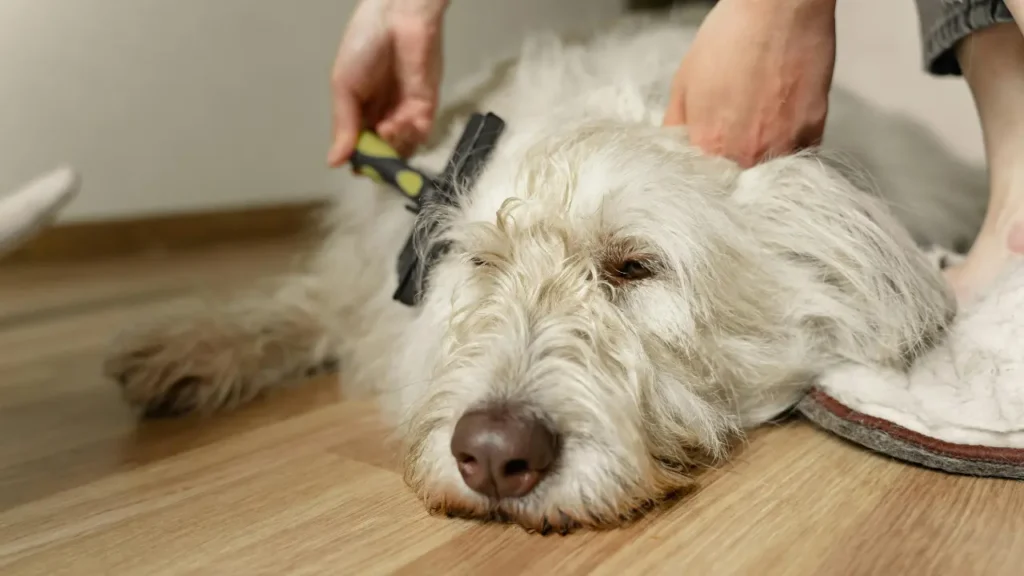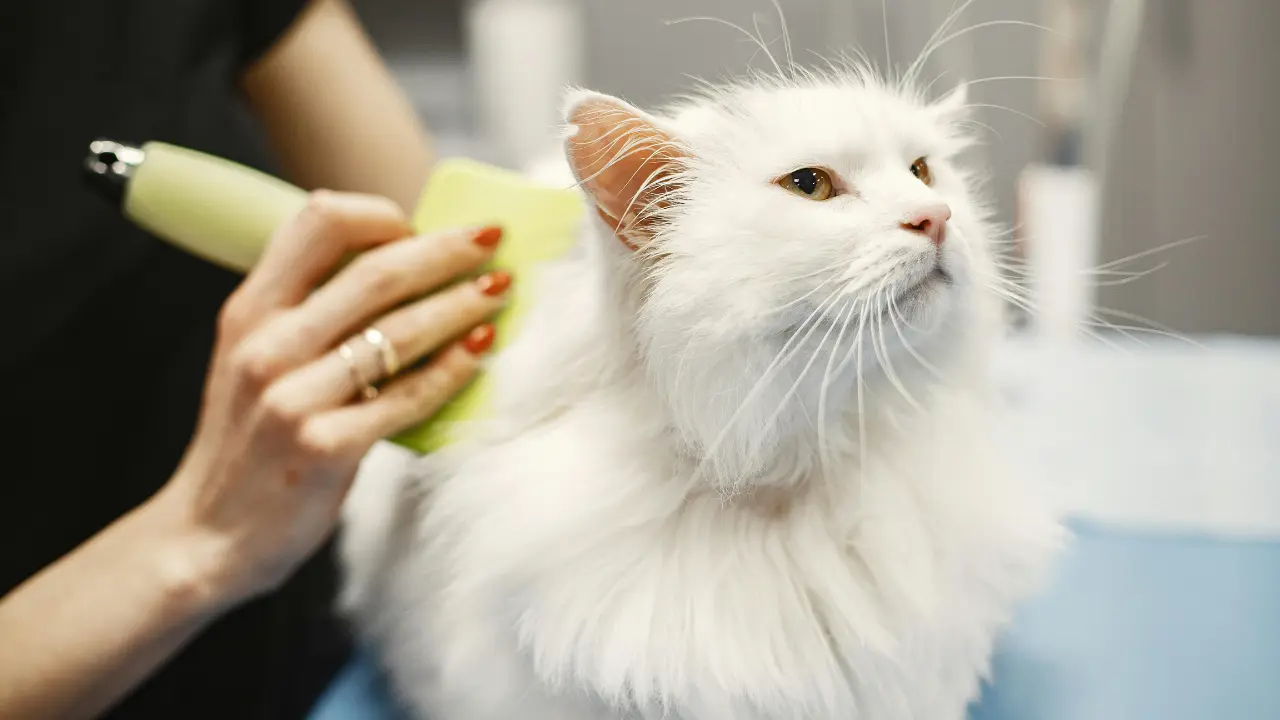Introduction
Pet grooming isn’t just about keeping your furry friend looking their best; it’s an essential part of their overall health and well-being. Regular grooming helps manage shedding, prevents matting, and keeps an eye out for potential health issues. While professional grooming services are great, grooming at home offers numerous benefits, including cost savings and the chance to bond with your pet. In this guide, we’ll explore how to effectively groom your pet at home, making the process as smooth and enjoyable as possible for both you and your furry companion.
Essential Grooming Tools
Brushing Tools
Types of Brushes and Combs
The right brush or comb can make a huge difference in grooming efficiency. Slicker brushes, deshedding tools, and grooming gloves each serve a specific purpose. For example, slicker brushes are excellent for removing loose fur and tangles, while de-shedding tools help manage shedding in double-coated breeds.
How to Choose the Right Tool
Consider your pet’s coat type and length when choosing grooming tools. Long-haired pets may need a different type of brush compared to short-haired ones. Invest in quality tools that will be effective and comfortable for your pet.
Bathing Supplies
Recommended Shampoos and Conditioners
Choose pet-friendly shampoos and conditioners that suit your pet’s skin and coat type. Hypoallergenic and moisturizing formulas are great for pets with sensitive skin. Avoid human shampoos, as they can disrupt your pet’s natural skin balance.
Bathing Tools and Accessories
Bathing tools like handheld shower heads, non-slip mats, and grooming gloves can make the process more efficient and comfortable for your pet. Ensure you have everything you need before starting the bath.
Nail Trimming Tools
Types of Nail Clippers
Various nail clippers are available, including guillotine-style clippers and scissor-type clippers. Choose the type that feels most comfortable for you and is best suited for your pet’s nail size and hardness.
How to Safely Trim Nails
Trim your pet’s nails carefully to avoid cutting into the quick, which can cause bleeding. If you’re unsure, start by trimming just a small amount and gradually increase as you gain confidence.
Ear and Teeth Care Tools
Cleaning Supplies for Ears and Teeth
Ear cleaners and toothbrushes specifically designed for pets can help maintain ear hygiene and dental health. Regular ear cleaning and tooth brushing are crucial to prevent infections and dental diseases.
Importance of Regular Care
Maintaining your pet’s ear and dental health can prevent more serious issues down the road. Make these tasks part of your regular grooming routine to keep your pet comfortable and healthy.
Grooming Techniques for Different Pets

Dogs
Brushing and Bathing Techniques
For dogs, brushing helps prevent mats and tangles and reduces shedding. Bathing should be done as needed, depending on the dog’s activity level and coat type. Use appropriate dog shampoos and conditioners to maintain coat health.
Nail Trimming and Ear Cleaning
Nail trimming and ear cleaning are also important. Regularly check and trim your dog’s nails to avoid overgrowth and potential injuries. Clean ears with a pet-safe cleaner to prevent infections.
Cats
Grooming Needs and Preferences
Cats have varying grooming needs based on their coat length and type. Long-haired cats require more frequent brushing to prevent mats, while short-haired cats might need less attention. Most cats groom themselves, but they still benefit from regular brushing and occasional baths.
How to Handle Cats During Grooming
Grooming cats can be challenging due to their independent nature. Use gentle handling techniques, and consider using treats to create positive associations with grooming.
Small Pets (Rabbits, Guinea Pigs, etc.)
Unique Grooming Requirements
Small pets like rabbits and guinea pigs require specific grooming routines. Regular brushing helps prevent mats in long-haired breeds, and nail trimming is crucial for all small pets.
Tips for Handling Small Pets
Handling small pets requires patience and gentleness. Create a calm environment and use proper techniques to avoid stressing your pet during grooming.
Step-by-Step Grooming Process
Preparing for Grooming
Setting Up a Safe and Comfortable Area
Choose a quiet, comfortable space for grooming where your pet feels safe. Ensure you have all your grooming tools and supplies within reach to avoid interruptions.
Gathering Supplies
Before starting, gather all necessary grooming tools, including brushes, shampoos, nail clippers, and any other items specific to your pet’s needs.
Brushing and Detangling
Techniques for Effective Brushing
Start by brushing your pet gently, working through tangles and mats slowly to avoid discomfort. Use the appropriate brush for your pet’s coat type and length.
Handling Mats and Tangles
For stubborn mats, use a detangling spray or conditioner and gently work through the tangle with a comb or brush. Avoid pulling too hard, as this can cause pain.
Bathing
How to Properly Bathe Your Pet
Wet your pet thoroughly with lukewarm water before applying shampoo. Massage the shampoo into the coat, rinse thoroughly, and apply conditioner if needed. Ensure all soap is rinsed out to avoid skin irritation.
Drying Techniques
Dry your pet with a towel or a pet-specific blow dryer set on low. Avoid using human blow dryers, as they can be too hot and uncomfortable for pets.
Nail Trimming
Steps for Safe Nail Cutting
Hold your pet’s paw gently and trim a small portion of the nail at a time. If you see a pinkish area (the quick), avoid cutting too close to it. Use a nail grinder for a smoother finish if clippers are too daunting.
Dealing with Nail Clipping Challenges
If your pet is nervous about nail trimming, try desensitizing them gradually by touching their paws and offering treats. Consider seeking help from a professional if needed.
Ear and Teeth Cleaning
Methods for Cleaning Ears and Teeth
Use a pet-specific ear cleaner and cotton balls to gently clean the ear canal. For dental care, use a pet toothbrush and toothpaste to brush your pet’s teeth regularly.
Avoiding Common Mistakes
Avoid using cotton swabs or human cleaning products in your pet’s ears. For dental care, don’t use human toothpaste, as it contains ingredients that can be harmful to pets.
Dealing with Grooming Challenges
Fear and Anxiety
Techniques to Calm Anxious Pets
Use calming aids like pheromone diffusers or soothing music. Gradually accustom your pet to grooming tools and processes to reduce anxiety.
Creating Positive Associations with Grooming
Incorporate treats and praise into the grooming process to create a positive experience. Start with short grooming sessions and gradually increase the duration as your pet becomes more comfortable.
Skin Sensitivities
Identifying and Managing Skin Issues
Look out for signs of skin irritation or allergies, such as redness or itching. Use hypoallergenic grooming products and consult your vet if you notice persistent issues.
Choosing the Right Products
Select grooming products designed for sensitive skin to prevent irritation. Always test a small amount of a new product before using it extensively.
Maintaining a Grooming Schedule
Frequency of Grooming
How Often to Groom Different Pets
The frequency of grooming depends on your pet’s coat type and lifestyle. Long-haired pets may need more frequent grooming than short-haired ones, and active pets might require more regular baths.
Creating a Grooming Routine
Establish a grooming schedule that fits your pet’s needs and your own routine. Consistency helps keep your pet’s coat and skin healthy and prevents issues from escalating.
Signs Your Pet Needs More Frequent Grooming
Recognizing Indicators of Overdue Grooming
Look for signs such as excessive shedding, visible mats, or a strong odor. If your pet seems uncomfortable or their coat looks unkempt, it may be time for an extra grooming session.
DIY Grooming vs. Professional Grooming
Advantages of DIY Grooming
Cost Savings and Convenience
Grooming at home is cost-effective and allows you to address grooming needs as they arise. It also provides a great opportunity for bonding with your pet.
Bonding with Your Pet
Regular home grooming strengthens your bond with your pet. The one-on-one time helps build trust and can make grooming less stressful for your pet.
When to Seek Professional Help
Situations That May Require a Groomer
Consider professional grooming for complex tasks or severe matting, or if your pet has special needs. Professionals can also assist with grooming if your pet is particularly anxious or difficult to handle.
How to Choose a Professional Groomer
Look for groomers with good reviews and recommendations. Ensure they have experience with your pet’s breed and are known for treating animals with care and respect.
Conclusion
Grooming your pet at home can be a rewarding experience that contributes to their overall health and happiness. With the right tools, techniques, and patience, you can handle most grooming tasks yourself, saving money and strengthening your bond with your furry friend. Remember to adapt your approach based on your pet’s specific needs and consult a professional when necessary. Happy grooming!
FAQs
Q1. How often should I groom my pet at home?
The frequency depends on your pet’s breed and coat type. Long-haired pets generally need more frequent grooming than short-haired ones. Regular brushing and occasional baths are usually sufficient.
Q2. What are the best tools for grooming a long-haired cat?
For long-haired cats, a slicker brush, a metal comb, and a de-shedding tool are ideal. These tools help manage tangles and prevent mats.
Q3. How can I calm my pet during grooming?
Create a calm environment, use soothing techniques like treats and praise, and gradually introduce grooming tools to reduce anxiety. Regular positive reinforcement helps.
Q4. What should I do if my pet has a skin reaction to grooming products?
Stop using the product immediately and consult your vet for advice. Opt for hypoallergenic products and ensure you’re using items specifically designed for pets.
Q5. When is it best to consult a professional groomer?
Seek professional help if you encounter severe matting, your pet has specific grooming needs, or if grooming causes significant stress. Professionals can also assist with advanced grooming techniques.

